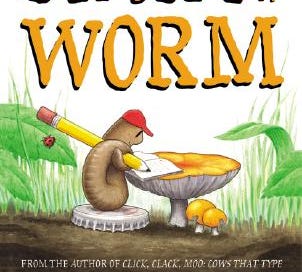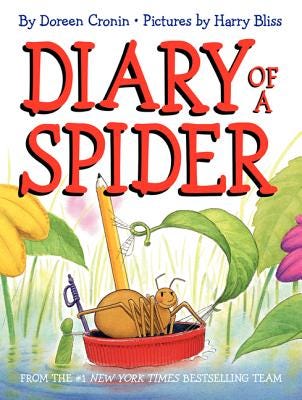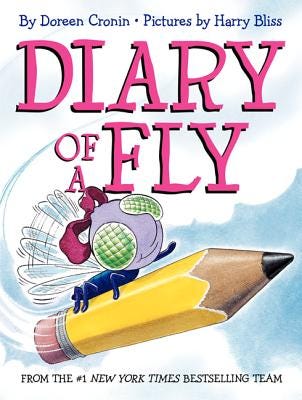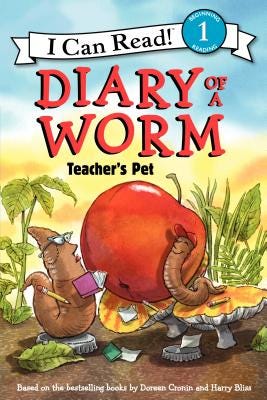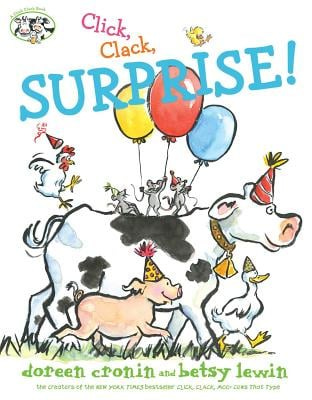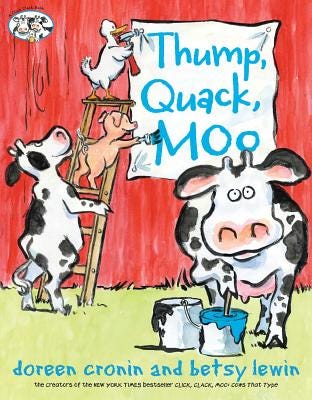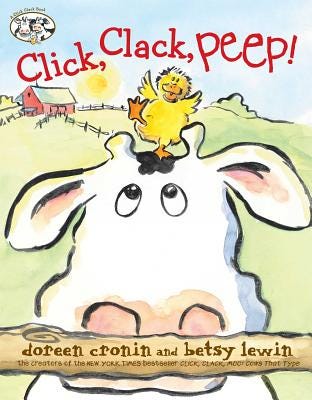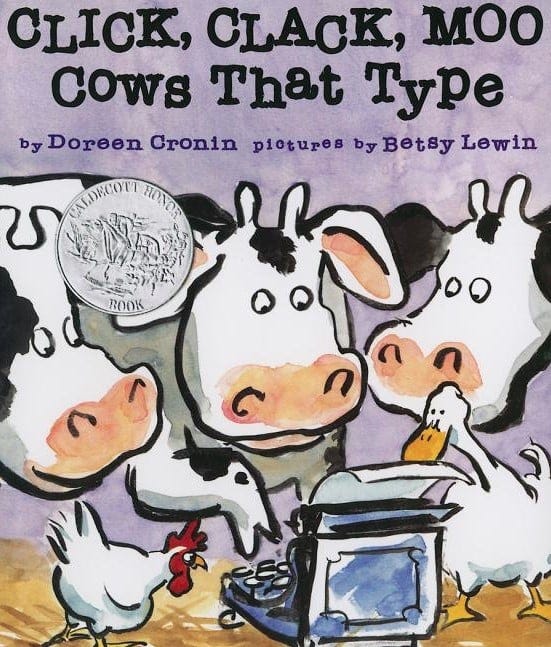The Diaries With Harry Bliss
I ran across Diary of a Worm recently and got a real kick out it. It reminds me of Gary Larsen’s Far Side cartoons, except geared towards toddlers and munchkins. Not only was the book amusing, I think for both the child and the adult (I actually guffawed at one point…not a usual for me in a picture book!), but it also had wonderful perspective shifts. The reader is guided into seeing the world through the eyes of a young worm.
I was so impressed with the book, I decided to swing by the library and check out every book I could find by the same author, Doreen Cronin. Turns out, she has quite a collection. I took all the books the library had available. Don’t worry, I returned them all straight away, so hopefully no munchkins were book-deprived in the making of this post. I read and re-read all twenty of them in one sitting. (Yes! That was quite satisfying to report to my husband!)
Here’s what I have to say:
I love her Diary of a… books, which include Diary of a Worm, Diary of a Spider, and Diary of a Fly. All three books interlink with one another as the worm, spider, and fly are all friends. Each one gives the size and visual perspective of the corresponding animal, though also hilariously via anthropomorphism the way human activities would be taken on by those animals.
I even mostly enjoyed the two I Can Read books: Diary of a Worm; Teacher’s Pet and Diary of a Worm: Nat the Gnat, though less so than the three above books. The two I Can Read books did well to extend the story and if your child loves the characters, that could be quite inspiring to read the book him- or herself. Otherwise, though, I did not find the charm of the perspectives shifts of the original to be as prevalent in the I Can Read books. I also have a distaste for too raunchy of behavior, especially that displayed by the “adults” in the story, if it cannot be counterbalanced by the story (e.g. the father letting out a huge burp). There was nothing in the books I would say were completely out of line, but simply not much worth singing high praises either. They were simply extensions to a familiar world.
To note, all of the above books were illustrated by Harry Bliss. I’m not sure how much of the Diary books illustrations were his personal contributions to the story and how much were suggested by the author, but it is quite possibly his pictures which really made the books truly special. I enjoyed the humor of the illustrations in addition to his ability to create the perspectives.
Two Endearing Picture Books with Brian Cronin
Mama In the Moon is a sweet book about a baby sloth who falls out of his mother’s grasp high up in the tree. [According to the book, sloths fall out of a tree on average once a week for its entire life. Who knew!] While the baby sloth is waiting for the mama sloth to come (slowly) down to get him, she reassures him and encourages him to pay attention to the sensations of beauty in the world around him.
Out of all of the books here, this one is my favorite for illustrations. It is filled with a type of happy-sad that is filled with imagination and wisdom, love and quietude. This pictures didn’t just help tell the story, they made them deeper, quieter, more solemn. By far, this one is my favorite. To me, the pictures almost contained their own soundtrack, but with visuals for sound. As a musician, that struck me deeply. I think this would be a nice contemplative-before-bed wind-down story and it is now on top of my Meemaw List.
Lawrence & Sophia is an equally sweet story of a boy and a bird who form an unlikely friendship. I found that this book touched my inner child who is by nature an introvert. I cannot help but wonder if it was patterned off of a child on the autism spectrum and might particularly speak to such a child. (Please let me know in the comments your experiences!)
The illustrations remind me of a cross between one of my favorite illustrators: Ilon Wikland crossed with Theodore Geisel…especially the trees. Again, the illustrations tell the story with or without the words and are deeply touching in and of themselves.
Boom Snot Twitty with Renata Liwska
This is a cute book. I love the illustrations. It’s sort of a variation on Goldilocks and the Three Bears, except with a Taoist twist.
Though it is a short picture book, there are some springboards in here worth mentioning: reading comics, knitting all sorts of stuff, having a lemonade stand, making paper airplanes, eating sunflower seeds from the head of a sunflower, reading by firefly…you know, all the good stuff in life!
Stretch, Bounce and Rescue Bunnies with Scott Menchin
Stretch and Bounce are two books that are two fairly cute. They are more for the one to two year old crowd. I’m personally not a big fan of illustrated books that intermix cartoons and photographs, but that’s just me. But, they’re not so bad as far as rhymes, opposites, and perspectives are concerned.
Rescued Bunnies is entirely cartoon. It reminds me vaguely of Richard Scarry illustrations. On the one hand, the message is not entirely bad: putting your heart into something, having empathy, being willing to sacrifice yourself to save someone else. On the other hand, I’ve personally had enough of the stories where the newcomer/ child/girl knows best. It is not that there is anything wrong with this story per se, but that the entire culture is one of sassy-girl-power and I’ve personally experienced in my capacity as a private music teacher how a nonstop barrage of this kind of story can very easily turn the child toxic and unteachable because the stories they are told are that the child always knows best. As I said, this one is not so bad, but after experiencing what I did as a teacher, I would say there are far better themes to have children learn. I did, however, enjoy the little Easter Eggs for the (grand)parents in the form of allusions to movies, like Airplane and Casablanca.
The Chicken House with Stephen Gilpin
The illustrations in this book remind me of Warner Brothers cartoons. That’s the biggest compliment I can give to the book, depending upon how much you like Warner Brother cartoons. (Personally, I find this a shame because I’ve found quite a lot of Stephen Gilpin’s work to be really amazing.) Although the book gives lip service to family being together and one neighbor helping another, the overall thrust of the book is about entitlement, self-gratification, and lack of appropriate boundaries. Once again, there is something of a twist on the Goldilocks theme, but the cartoon squatter version. In my opinion, there are better books out there to read to kids or have kids read to themselves that don’t encourage kids to draw on the walls of other people’s houses, which apparently in the book we’re all supposed to find adorable.
Click Clack Books with Betsy Lewin
I really like the illustrations in these books. The pictures are fun and tell their own story. The pictures alone are what make the books worth reading. To be fair, there are some fun rhymes and silly sounds that kids love. There’s a style and formula that goes along with the pictures as well.
Click Clack Surprise and Click Clack Surprise (Ready To Read) is my favorite of the series. It is the story of Little Duck’s birthday and is an adorable tale of what happens when you simply copy other people. I like it because it touches upon seeing the world through the eyes of another at the same time as seeing what is good for one is not necessarily good for another. These are quite complex and abstract ideas packed amazingly well into a concrete way that even a toddler can start to appreciate the nuance. The Ready to Read version is essentially the exact same book, simply formatted differently.
Click Clack Good Night is my second favorite of the series. It’s a classic I-Can’t-Sleep book. The pictures are wonderful and can serve to be part of a winding down process for the child.
Thump, Quack, Moo is another book that I have mixed thoughts. On the one hand, a farmer gets the animals to pull together to make a corn maze, each having their own jobs, though I’m a little unsure how great of a business model it is to go through all of the work of setting up a business in order to have the only people paying for the corn maze to be the farmer and the duck themselves, but ok, let’s leave that aside. There are some cute variations to the Click, Clack, Moo, like Cluck Whack, Moo Thwack, and Thump Quack. Then there’s the threats to Duck that should he not help, he will not get his food. There’s the poor attitude, the sneaking around and undermining the farmer, and of course, we can only hope Duck is actually wearing a parachute when he jumps from the hot air balloon. With that said, it is a funny perspective shift to have the Statue of Liberty open out to become…sorry, too much of a spoiler….
Click, Clack, Peep! is another version of the get-the-baby-to-sleep book. Suffice to say that I prefer the other book, though I guess some might find it hilarious that the duck steals the tractor and destroys the farm in order to put the baby chick to sleep. I remember once upon a time when I could read these kinds of books without being traumatized. With that said, once these books became a childhood norm, the number of similar incidents I had happen inside of my music studio skyrocketed. There’s only so many times when you have a little student purposefully destroy one of your teaching tools, often having snuck behind my back to get to it, only to laugh maniacally at the destruction…all while the parent sits there and smiles with pride at how “cute” their child is being. No. Not once did a parent offer to pay for the destroyed object. Not. One. Single. Time. So, I’m really not fond of books that encourage kids to find this type of behavior as “cute” or acceptable. My two cents.
Click, Clack, Boo! is a cute Halloween book.
Click, Clack, Moo Cows That Type is surprisingly/unsurprisingly my least favorite of all the books. With that said, let me take a moment to sing the praises of the illustrator: Betsy Lewin. A note in the beginning speaks to how the artist went about making her illustrations. I think it is worth noting:
For this book, I did brush drawings using Windsor Newton lamp black watercolor on tracing paper. I then had the drawings photocopied onto one-ply strathmore kid finish watercolor paper and applied watercolor washes to the black drawings. The advantage to this method is that I can get as many copies on the watercolor paper as I want, and I can experiment with the color, choosing the finishes that I like the best.
I’m really not sure what all that means, as I’m not an artist, but I really love that they include the note of explanation. One so rarely gets so edified by the artist in a children’s picture book. I wish all kid’s books had those little tidbits. (Putting that out there in the universe.)
Needless to say, I do really love the illustrations!
As to the story, on the surface it is also cute. It has a nice structure, humor, and nice cadence and rhythm. There is a problem (the cows and subsequently the ducks want electric blankets). They go on strike to be given electric blankets. On the one hand, it’s funny. The animals get their way…sort of…and there is a funny ending. On the other hand, as one who has personal reasons to be traumatized by socialist-adjacent ideology, this kind of story tends to set off the hair at the back of my neck and rub me to the wrong way.
Parting Thoughts
Though I have on many occasions binge read an author’s entire repertoire, this is one of the first times that I have been so struck by the wide variety of illustrators that came along with the same author. It was quite enlightening as to how much an illustrator can add to a storyline and how much depth the illustrations bring to the story. This would be an interesting project for any budding authors and illustrators out there. An even better project would be to have someone write down the words of the author’s, then have another person design the pictures to tell the story and see how alike or different they are. Likewise and probably easier, one might look at the pictures and tell the story without looking at the words.
That’s just my opinion, though, what are your thoughts?
Do you know these books? If so, please enrich us all by adding your experiences!

